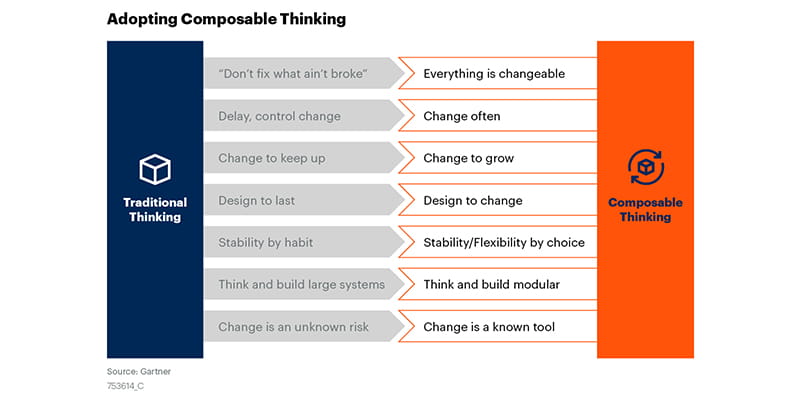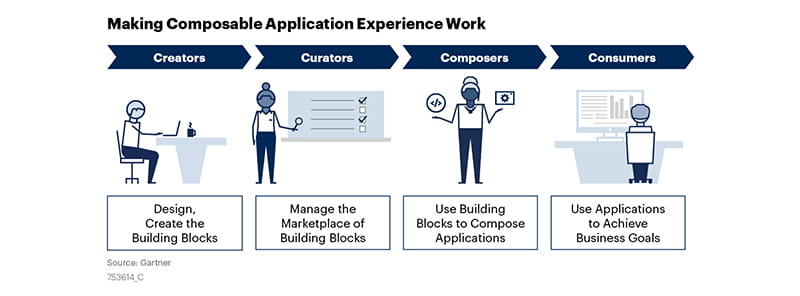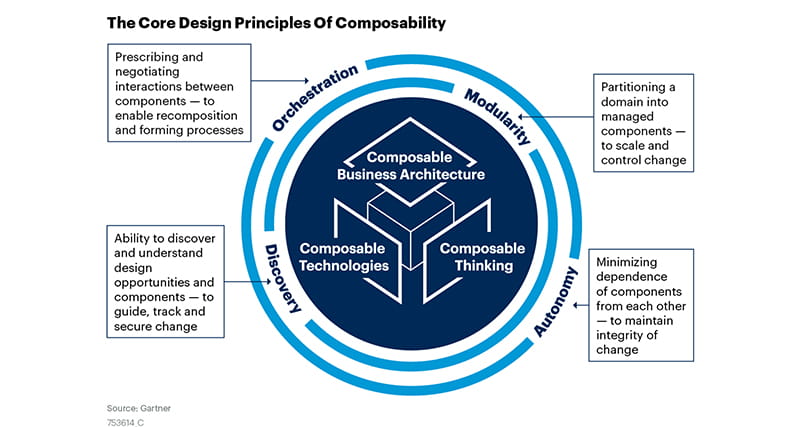Leveraging Composable Architecture to drive unforgettable digital experiences
From customer-centric companies to small startups, businesses of all sizes are looking for ways to bring greater consumer trust and engagement to their products. With digital experience, brands can create immersive and interactive user experiences that drive meaningful interactions between them and consumers.
As attention spans get smaller, consumers are becoming uncompromising with their needs and preferences. With the rising competition for delivering unmatched customer experience, one single brand interaction can influence the customer’s trust and lead to a quick shift in loyalties.
With faster application development speed, modernized infrastructure and greater agility, Composable architecture has gained popularity among developers to improve the time to market and elevate customer experience at scale.
By 2024, organizations that have adopted a composable approach to application architecture will implement new features by at least 80% faster than the competition." (Gartner, by Alan D. Duncan)

What is composable and microservices-led architecture?
"CIOs must find the IT force multipliers to enable growth and innovation and create scalable, resilient technical foundations whose scalability will free cash for digital investments. These imperatives form the three themes of this year’s trends: engineering trust, sculpting change, and accelerating growth."
David Groombridge, research vice president at Gartner
With a composable architecture, you can break down the functionalities of your business application into smaller components, or microservices. These microservices can be autonomous units that are designed for specific use cases and can independently evolve without affecting other parts of the system. The app has fewer dependencies with other apps which makes maintenance easier as well as faster iteration times since changes don’t need to propagate across multiple layers in code.
The microservices-led architecture has gained popularity over the last few years due to its ease of deployment and scalability, which allows developers the buffer to individually test solutions and make necessary enhancements on-the-go.

In this blog, we will discuss the benefits of leveraging a composable architecture for business applications and also compare against monolithic architectures, which is typically a large code base which requires deployment in one go.
1. Application Up-time
With a monolithic application architecture, for adding new enhancements to the application the entire system typically needs to be overhauled and updated leading to huge effort and potential down times. The composable architecture uses a decentralized approach, it does not hamper the existing application functionalities during a new update, therefore, it diminishes the problem of application downtime altogether, providing a 99.9% uptime in most scenarios.
2. Enhanced Performance
Monolithic systems are centralized and rigid, they do not provide the provision for maximizing the capacity or architecture on-the-go. Businesses need to keep maximizing the hardware capacity as their demand grows, this puts an undue financial burden on the business and is not sustainable to tap a longtime growth.
On the other hand, a composable architecture can be easily hosted on cloud and orchestration platforms like Kubernetes, which provide auto-scaling, which is linked to application usage and resource demands, thereby, enhancing application performance at no extra costs.
3. Deliver Unmatched Customer Experiences
Customer experience has become the playground for businesses across sectors to build lasting customer relationships, drive lifetime customer loyalties and tap their growth potential. With customers demanding personalized communications across multiple channels, driving digital experiences that stick is no longer a choice but a strategic business goal.

Microservices-led architecture empowers businesses to seamlessly integrate new digital transformation tools and technologies with the existing technology stack to deliver contextual omnichannel customer experiences at scale.
Espire assisted a leading UK-based insurance company enhance their digital transformation journey with an agile quote and buy system. Our solutions improved customer experience and customer retention. Read more in our case study!> here
4. Improve Application Security
The communication between two microservices is encrypted and controlled with service mesh proxies and extensive policies, this not only provides an additional layer of data protection but also removes the dependency on developers to design a security program especially for the application.
With an API gateway integration, developers can provide a single monitored platform for all service requests. A composable architecture improves application security and provides the business greater control over confidential customer data.
5. Greater Application Flexibility
As the business expands in size and geographical footprint, new modules are required to be developed to meet the demands of different business domains. With CI-CD pipelines and container methodologies, developers can test and release functionalities specific to the unique business requirements.

Composable architecture makes it easier for developers to carry out change enhancements and software modifications which complement a unique customer segment. With automated testing and faster deployments, a microservices-led architecture provides greater application flexibility while elevating employee productivity and operational experience.
MACH Alliance
Composable shifts the focus from infrastructure to an API-first approach. By 2024, the mantra for new SaaS will be "composable API-first and API-only, "relegating traditional SaaS vendors as “legacy.”
There is even a formal association advocating the composable approach- MACH Alliance - wherein “MACH” is an acronym for “Microservices based, API-first, Cloud-native SaaS and Headless”.
According to the MACH Alliance, "Enterprise suites are no longer the safer choice. The MACH ecosystem is. It is agile and nimble, always up to date.” The Alliance thus wants to “future proof enterprise technology and propel current and future digital experiences."
As for composable, they identify it as an architecture "in which every component is pluggable, scalable, replaceable, and can be continuously improved through agile development to meet evolving business requirements."
Summing Up
Gartner predicts that by 2023, 60% of businesses will seek composability in new application investments.
In today’s disruptive market, business leaders need to focus on modernizing their application infrastructure to complement the dynamic business needs and goals. A composable microservices-led architecture allows the application to adapt to the speed of business while enhancing responsiveness and scalability, paving the way towards driving greater growth.
To keep pace with the changes in customer preferences and brand goals, we help businesses deploy our Total Experience solutions to design composable microservices-based digital platforms and applications best-suited to their business needs to fast-track their growth. Know more about our digital engineering capabilities!> here (/services/digital-engineering ) or write to us at marketing@espire.com

